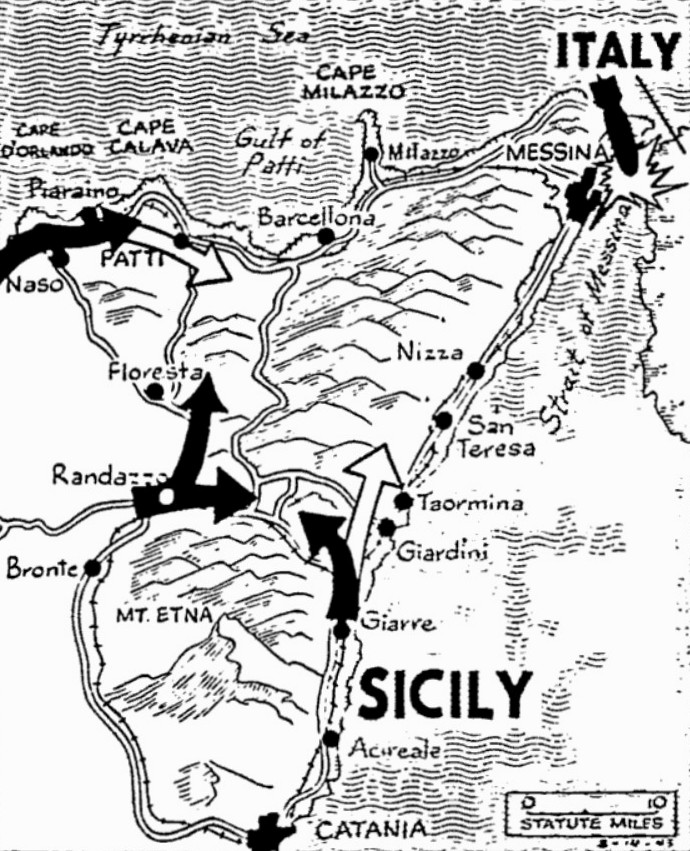The Pittsburgh Press (August 15, 1943)
GERMANS CRUSHED, FIGHT TO FLEE SICILY
Planes blast Axis attempt at ‘Dunkirk’
Allied forces racing to cut off enemy troops at Messina
By Reynolds Packard, United Press staff writer

Beginning of the end in Sicily was marked by collapse of Axis defense lines in the northeastern corner of the island, with German and Italian forces streaming for the mainland from Messina and other points under a rain of Allied bombs. British and U.S. forces were driving to a junction around Mt. Etna and along the coastal roads, indicated by the arrows.
Allied HQ, North Africa – (Aug. 14)
Allied troops crashed through broken Nazi defenses on the entire Sicilian front tonight, capturing six more towns in a race for Messina while allied planes bombed and strafed scores of boats loaded with fleeing troops.
As the campaign reached a virtual mop-up stage, it was officially announced that the Germans are trying to carry out a major evacuation of their Sicilian bases.
Ring Mt. Etna
Streaming east from the fallen citadel of Randazzo, the Americans drove on Castiglione, almost completing an Allied ring around Mt. Etna while farther north other Yankees captured Floresta on the Randazzo-Capo d’Orlando road, and Piraino on the coast.
The British 8th Army took Fiumefreddo and Riposto on the east coast, Giarre just inland and Milo, nine miles from the summit of Mt. Etna.
By advancing five miles to Fiumefreddo, the 8th Army sealed off the road from Randazzo to the east coast, trapping any Germans in transit although it was believed most of the enemy had withdrawn except for suicide machine-gunners emplaced on the heights.
Many of foe captured
After reaching Giarre, an 8th Army column swung off to the left across the rolling northeast slope of Mt. Etna to meet the Americans beating over from Randazzo and at last reports, the two armies were only 12 miles apart.
Allied advances in the last 48 hours had resulted in automatic collapse of entire sectors and large numbers of Axis troops were captured.
It was unofficially estimated that enemy prisoners now totaled between 140,000 and 150,000 for the campaign.
Leave boobytraps
Nowhere was the enemy’s resistance more than a brisk rearguard action, but in the wake of their withdrawal the Germans left countless mines, boobytraps and demolitions. Some roads were impassable for miles, especially in the 8th Army sector where the enemy could blow down overhanging ledges on the coastal road.
The Germans left Randazzo in flames and infested with mines and boobytraps which the Americans had difficulty in detecting because there was so much shrapnel and other metal debris in the streets that the warning bells on mine locating devices kept ringing constantly.
Attack in waves
In a full day of continued advances on their front, the Americans reported not a single major contact with the enemy.
As the campaign surged toward a victorious climax at Messina that bomb-blackened port was a fantastic jumble of Axis evacuation traffic while in the harbor and from surrounding beaches every imaginable type of craft put out with Nazi troops.
Overhead, Allied planes screamed down in waves to turn this little “Dunkirk” into death for hundreds of Germans who were mowed down in the beaches or spilled from blasted small craft into the three-mile strait.
Use luxury yachts
Reconnaissance photographs showed scores of launches, barges, landing craft and even commandeered luxury yachts plowing over to Italy loaded with troops and hurrying back empty, taking zigzag evasive tactics to escape the planes.
The regular strait ferry to San Giovanni and Reggio Calabria in Italy was now completely out, official reports stated, and with few heavy ships available the Germans were leaving nearly all their equipment on the Messina beaches.
In addition to evacuating across the Strait of Messina, the Germans were pulling out from the north coast port of Milazzo toward ports on the northwest side of the toe of Italy.
In a day of furious new blows on the retreating and evacuating enemy, Allied planes shot down 10 enemy aircraft in addition to sinking, driving on the beaches or damaging scores of escape boats. Only four planes were lost by the Northwest African Air Force in all operations which included Friday’s big Rome raid and swings over targets in Sardinia and southern Italy.
An Italian communiqué broadcast from Berlin said that Axis torpedo planes hit and probably destroyed a medium-sized Allied steamer and a destroyer in the Mediterranean and bombed ships in the Syracuse road-stand “with good success.”
